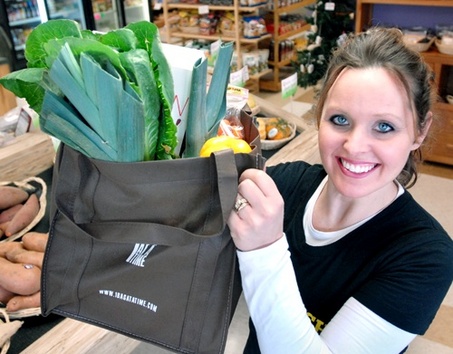"We were finding that deaths, for example, from foodborne illness or intestinal infections goes up from anywhere between 50% and 100%, so a doubling in some instances."
That’s what Jonathan Klick, a University of Pennsylvania Law professor states in reference to what he says is a major public health risk: jurisdictions enacting plastic bag bans that result in the increased use of reusable bags. Citing unshown and unpublished data from San Francisco, Klick also says "More people are showing up in the emergency rooms, and it turns out they have E. coli infections…" (2).jpg)
He implies those infections and illnesses can be traced to reusable bags. Uh huh.
According to The PERColator, Klick investigated the economic trade-offs of reusable bags during a fellowship funded by the Property and Environment Research Center this summer and he apparently has data to back this up, but I’m guessing here (because nothing is cited).
In research carried out at PERC this summer, Jonathan Klick, a PERC Lone Mountain Fellow, argues that reusable grocery bags contain potentially harmful bacteria, especially coliform bacteria such as E. coli. Klick finds that, in the wake of San Francisco’s ban, deaths and ER visits related to these bacteria spiked as soon as the ban went into effect. For more on this ongoing research, watch our interview with Klick (I’ve embedded it below -ben)
Klick says "There have been some science folks, who have done some studies…" and then a few stats are flashed up:
– 51% of tested bags contained coliform bacteria
– Bacteria grows even faster if stored in a car
Those science folks are Williams and colleagues (2011) who have published the only peer-reviewed study on the microbial safety of reusable bags and they tested 58 bags taken from shoppers in Arizona and California.
And E. coli matters more than coliform, since the group of bacteria is commonly found on plant material and is not a good indicator of pathogen presence on food. At least E. coli demonstrates that a pathogen might be there. The Williams study showed generic E. coli can float around in bags – they recovered it in 12% of what they sampled (n=58).
An unanswered question is can it be (or is it likely) to be transferred to any ready-to-eat foods, or somehow to food contact surfaces in the home? Seems like that matters. Just because the bacteria might be there, doesn’t mean it can contaminate a ready-to-eat food. No one has presented data to support that.
Williams and colleagues also tested growth of Salmonella in 2 batches. They spiked the bags with 10^6 cfu and let them sit in the trunk of a car for 2 hours. One of the batches, where the temperature reached 47C/117F, showed a one-log increase in the Salmonella. The other batch, where the temperature reached 53C/124F, there was a one-log reduction. That data doesn’t show just a breeding zone – it shows they can be a killing zone too (and I’m not sure how realistic a 10^6 contamination really is).
Shiny YouTube videos with dramatic music can grab attention – but without sharing the data and showing his work, Klick isn’t saying much.



.jpg)
 And prudence before plastic pushers.
And prudence before plastic pushers..jpg)